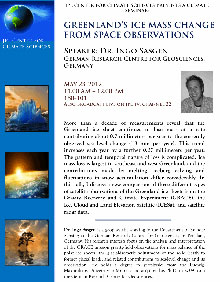Seminars
Greenland's Ice Mass Change From Space Observations
Dr. Ingo Sasgen, German Research Centre for Geosciences, Germany
May 23, 2012 | Jet Propulsion Laboratory, 11.00 am-12.00 pm, 180-101
About this Lecture

More than a decade of measurements reveal that the Greenland ice sheet continues to lose mass at a rate contributing about 0.7 millimeters per year to the currently observed sea level change (~3 mm per year). This trend increases each year by a further 0.07 millimeters per year. The pattern and temporal nature of loss is complicated. Ice mass loss is largest in southeast and west Greenland, and the contributions made by melting, iceberg calving and fluctuations in snow accumulation differ considerably. In this talk, I discuss a new comparison of three different types of satellite observations of the Greenland ice sheet: from the Gravity Recovery and Climate Experiment (GRACE), the Ice, Cloud and Land Elevation Satellite (ICESat) and satellite radar data.
About Dr. Ingo Sasgen

Dr. Ingo Sasgen is a geophysicist working in the Department of Remote Sensing at the German Research Centre for Geosciences, in Potsdam, Germany. His research interests focus on the analysis and interpretation of the GRACE mission gravity-field observations for mass balance of the polar ice sheets, the glacial-isotactic adjustment of the solid Earth to former glacial loads, and related contributions to sea-level change and its observation. He holds a degree in geophysics from the Ludwig-Maximilians University in Munich and acquired his Ph.D. in 2009 from the German Research Centre for Geosciences.
